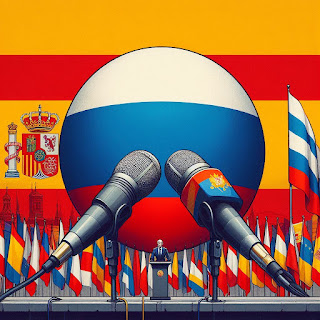Languages play a crucial role in shaping culture, identity, and communication in any society. In the context of Russia and Peru, the primary languages—Russian and Spanish—reflect the unique histories and social dynamics of each country.
Russian is an
East Slavic language and serves as the official language of Russia. It is one
of the most widely spoken languages in the world, with millions of speakers not
only in Russia but also in neighboring countries and among diaspora communities
globally. Russian has a rich literary tradition, with renowned authors such as
Leo Tolstoy, Fyodor Dostoevsky, and Anton Chekhov contributing to its cultural
depth.
The Russian
language uses the Cyrillic alphabet, which has a distinct look compared to the
Latin alphabet used in many other languages. The grammar can be complex,
featuring six cases, which affect how words change depending on their function
in a sentence. This complexity can pose challenges for learners, but it also
adds to the richness of expression in the language.
Russian is
also a language of science and technology. During the Soviet era, it was a
lingua franca for many Eastern Bloc countries and remains important in
international diplomacy and global studies today. As Russia seeks to expand its
influence, proficiency in Russian can open doors in fields ranging from
business to politics.
Spanish, on
the other hand, is the official language of Peru and is one of the most spoken
languages worldwide, particularly in Latin America and Spain. The language has
a diverse range of dialects and accents, which can vary significantly from one
region to another. In Peru, there are also numerous indigenous languages
spoken, but Spanish is the primary means of communication in government,
education, and media.
Peru’s
Spanish has been influenced by its rich cultural history, including indigenous
languages like Quechua and Aymara. This influence is evident in the vocabulary,
pronunciation, and even in some grammatical structures. Peruvian Spanish also
has a vibrant literary tradition, with contemporary authors like Mario Vargas
Llosa earning international acclaim.
Spanish is a
language of international commerce and diplomacy, and its growing importance in
global markets makes it a valuable asset for Peruvians in various professional
fields. As trade and cultural exchanges increase, proficiency in Spanish can
facilitate connections with other Spanish-speaking nations.
Both languages carry significant
cultural weight. Russian embodies the complex history and vast geography of
Russia, while Spanish reflects the diverse cultural tapestry of Peru. Each
language serves as a vessel for the values, traditions, and stories of its
people.
The linguistic divide between Russian
and Spanish can create interesting opportunities for language exchange. As
globalization continues to connect people across borders, there’s an increasing
interest in learning these languages for travel, business, and cultural
appreciation. Language schools and online platforms facilitate this exchange, fostering
greater understanding between Russian and Spanish-speaking communities.
Russian uses
the Cyrillic alphabet, which consists of 33 letters. This writing system was
developed in the 9th century and has its roots in the Glagolitic alphabet,
created by Saints Cyril and Methodius. The Cyrillic alphabet is distinct and
visually different from the Latin alphabet used by many other languages,
including Spanish.
The Russian
language is phonetic, meaning that words are generally pronounced as they are
written, although there are exceptions. The use of cases in Russian grammar
influences the form of words based on their grammatical role, which can be seen
in the written language as well. The intricacies of Russian writing reflect the
complexity of its grammar and the rich cultural heritage of the country.
Spanish uses
the Latin alphabet, which consists of 27 letters, including the additional
letter "ñ." This alphabet is widely used across many languages,
making it more familiar to a global audience. Spanish is also a phonetic
language, and its spelling typically corresponds closely to pronunciation.
One of the
distinctive features of Spanish writing is the use of diacritical marks, such
as accents (tildes) that indicate the stress on certain syllables. This aspect
is crucial for proper pronunciation and meaning. For example, "toma"
(take) and "tomá" (take it!) have different meanings based on the
presence of an accent.
In summary, Russian and Spanish are
more than just means of communication; they are integral to the identities of
their respective countries. Understanding these languages opens up a deeper
appreciation of Russia's and Peru's rich histories, cultures, and global
interactions. As the world becomes increasingly interconnected, the importance
of these languages will only continue to grow.


No comments:
Post a Comment